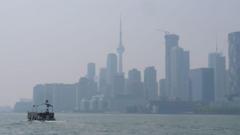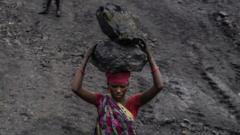With a national election approaching in Australia, citizens hold significant influence over climate policies that could reshape the nation's energy landscape.
Australia's Climate Policies on the Line in National Election

Australia's Climate Policies on the Line in National Election
Voters face crucial energy choices in upcoming elections, impacting climate future.
As Australia prepares for its national elections this Saturday, the stakes for climate change couldn't be higher. Among democracies, only the United States and Canada surpass Australia in per capita greenhouse gas emissions, while the nation's status as one of the leading exporters of coal and natural gas further complicates its climate narrative. Despite the critical nature of climate policies, recent polls suggest that many voters are not prioritizing environmental issues in this election cycle.
The leading contenders for the Prime Minister's office represent two contrasting views on addressing climate change: the Labor Party's focus on renewable energy expansion versus the Liberal-National Coalition’s push for nuclear power. This divergence reflects a deeper debate about the future of coal power in an economy heavily reliant on fossil fuels.
As Andrew Macintosh, a professor of environmental law and policy at the Australian National University, noted, the aging coal fleet that presently serves as the backbone of the nation's electricity supply is due for retirement, irrespective of climate considerations. “Labor's plan emphasizes sustainable energy advancements, while the conservative coalition’s nuclear strategy raises questions,” he stated. Nuclear facilities often require over a decade for construction, whereas renewable energy solutions can be implemented far more swiftly.
As the election looms and debates intensify, the power to influence the trajectory of Australia’s climate response rests in the hands of voters, who must weigh their choices carefully in light of both immediate and long-term environmental consequences.
The leading contenders for the Prime Minister's office represent two contrasting views on addressing climate change: the Labor Party's focus on renewable energy expansion versus the Liberal-National Coalition’s push for nuclear power. This divergence reflects a deeper debate about the future of coal power in an economy heavily reliant on fossil fuels.
As Andrew Macintosh, a professor of environmental law and policy at the Australian National University, noted, the aging coal fleet that presently serves as the backbone of the nation's electricity supply is due for retirement, irrespective of climate considerations. “Labor's plan emphasizes sustainable energy advancements, while the conservative coalition’s nuclear strategy raises questions,” he stated. Nuclear facilities often require over a decade for construction, whereas renewable energy solutions can be implemented far more swiftly.
As the election looms and debates intensify, the power to influence the trajectory of Australia’s climate response rests in the hands of voters, who must weigh their choices carefully in light of both immediate and long-term environmental consequences.





















